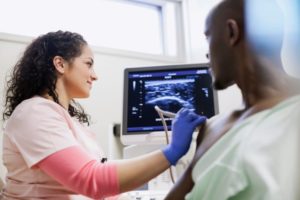
When you are dealing with a musculoskeletal health condition, one of the first things you need to do is learn about the problem. When you visit an orthopedic physician, they might recommend that you undergo an MRI scan, or they may use diagnostic ultrasound to examine you. What is the difference between these two technologies? This blog post explains some important information.
What Are They?
Both MRI and ultrasound have the ability to show your doctor what is going on inside your body. Magnetic resonance imaging (MRI) does so via the use of magnetic fields and radio waves, whereas ultrasound utilizes sound waves. Both technologies can provide an extremely detailed view of various tissues, including those that are often affected by musculoskeletal conditions.
When Is Diagnostic Ultrasound Better?
There are some situations in which diagnostic ultrasound is preferred over an MRI scan:
- A patient has an injury that is best examined during movement. Ultrasound can produce real-time images when a patient is moving their body. MRI, on the other hand, requires patients to stay very still.
- A patient has certain types of implants. Some types of bodily implants can make it dangerous for a person to undergo an MRI scan.
- A patient is claustrophobic. Many people feel uncomfortable or even afraid while in an MRI machine. Ultrasound is less intimidating for such individuals.
- A patient needs a precise injection. Ultrasound can be used during the injection process to make sure medications go exactly where they need to be.
When Is MRI Better?
An MRI scan might be preferred over ultrasound if:
- The doctor needs to see bones. Ultrasound waves cannot penetrate hard tissues, but an MRI can.
- A wide field of view is required. Ultrasound can be used to examine large parts of the body, but it may take more time. MRI can give a thorough overview of large body parts.
Which Do You Need?
If you are coping with musculoskeletal aches and pains, your doctor can determine whether you need an ultrasound scan or MRI scan. Often, ultrasound can provide all the necessary information without the stress and expense of going to a hospital for an MRI. However, there are instances when an MRI may be called for.
Both MRI and ultrasound are important diagnostic tools! Ask your doctor if you have questions about how they work.
Meet the Practice
Dr. Paul Tortland is an experienced osteopath who is well known for providing top-quality musculoskeletal and regenerative medicine treatments. Our team are experts in the use of musculoskeletal diagnostic ultrasound and have used it to help countless patients. To learn more about how we may be able to help you find relief from your aches and pains, contact Valley Sports Physicians & Orthopedic Medicine at 860-430-9690.
